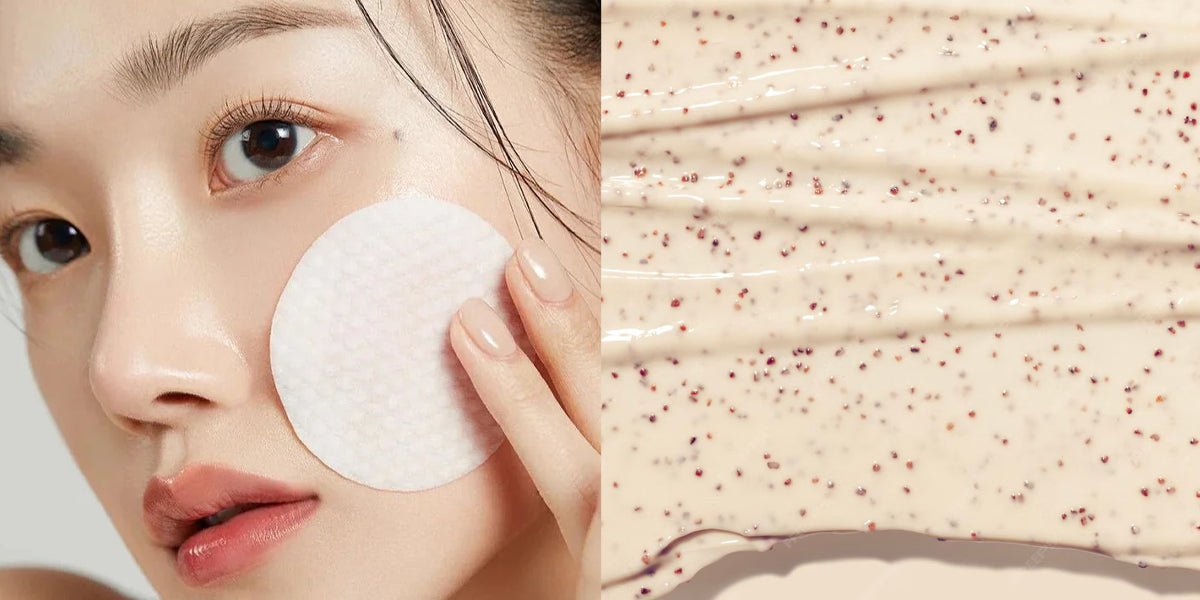
Exfoliation Showdown: Physical or Chemical—Which Does Your Skin Need?
|
|
読む時間 4 min
|
|
読む時間 4 min
When it comes to achieving radiant, smooth skin, exfoliation is non-negotiable. But with so many exfoliating methods out there, the big question remains—should you go physical or chemical? Both can give you that sought-after glow, yet they work in entirely different ways. Understanding which method suits your skin best can make all the difference between a bright, healthy complexion and one that’s red, irritated, or over-stripped.
In this guide, we’ll dive deep into the science of exfoliation, the pros and cons of each type, and how to incorporate them into your routine for long-term skin health.
Exfoliation is the process of removing dead skin cells from the surface of your skin. Our skin naturally sheds these cells every 28–30 days, but with factors like pollution, stress, and aging, this process can slow down. The result? Dull, rough, or uneven skin texture.
Regular exfoliation helps to:
Improve product absorption
Unclog pores and reduce blackheads
Enhance radiance
Even out skin tone
Stimulate collagen production
But not all exfoliants are created equal—which brings us to our two contenders: physical and chemical exfoliants.
| Type | How It Works | Common Ingredients | Best For |
|---|---|---|---|
| Physical Exfoliation | Uses small particles or tools to manually slough off dead skin cells | Sugar, salt, coffee grounds, jojoba beads, brushes | Normal to oily skin |
| Chemical Exfoliation | Uses acids or enzymes to dissolve dead skin cells without friction | AHAs (glycolic, lactic acid), BHAs (salicylic acid), PHAs, fruit enzymes | Dry, sensitive, or acne-prone skin |
Each method has unique benefits and potential downsides. Choosing the right one depends on your skin type, goals, and tolerance level.
Physical exfoliants have been around for centuries. From rice powder scrubs to facial brushes, they rely on physical friction to lift away dead cells.
Pros:
Instant smoothness after one use
Improves circulation and gives an immediate glow
Great for those who enjoy a tactile, spa-like experience
Cons:
Can be harsh if overused
May cause microtears, especially if using rough scrubs or walnut shells
Not ideal for sensitive or acne-prone skin
If you love that instant polish, opt for a gentle scrub with rounded particles like jojoba beads. Always apply with light pressure and never more than twice a week.
Chemical exfoliants are game changers in modern skincare. Instead of scrubbing, they dissolve the bonds holding dead cells together, allowing them to shed naturally.
Types of Chemical Exfoliants:
AHAs (Alpha Hydroxy Acids): Best for dry or dull skin; they hydrate while resurfacing. Examples include glycolic acid, lactic acid, and mandelic acid.
BHAs (Beta Hydroxy Acids): Oil-soluble and ideal for oily or acne-prone skin. Salicylic acid penetrates deep into pores to remove buildup.
PHAs (Polyhydroxy Acids): The gentlest of all; they exfoliate while providing hydration and antioxidant protection—perfect for sensitive skin.
Pros:
Offers deeper exfoliation with less irritation (when used correctly)
Improves fine lines, texture, and uneven tone over time
Enhances cell turnover for long-lasting radiance
Cons:
Overuse can lead to sensitivity or dryness
Requires consistent sun protection as skin becomes more photosensitive
Skin Type |
Best Exfoliation Type |
Recommended Frequency |
Notes |
|---|---|---|---|
Dry |
AHA-based chemical exfoliant (e.g., lactic acid) |
1–2 times a week |
Avoid gritty scrubs that strip moisture |
Oily |
BHA (salicylic acid) or gentle physical scrub |
2–3 times a week |
Focus on unclogging pores and reducing shine |
Combination |
A mix of both (alternate days) |
2 times a week |
Treat oily zones with BHA, dry zones with AHA |
Sensitive |
PHA or enzyme exfoliant |
Once a week |
Avoid friction-based scrubs altogether |
Normal |
Either method |
1–2 times a week |
Monitor skin response and adjust accordingly |
1. Start with a Clean Canvas
Always cleanse your face before exfoliating. This removes surface oil and impurities, allowing exfoliants to work effectively.
2. Apply Gently
If using a scrub, massage in light circular motions. For acids, apply with a cotton pad or fingers and let it sit—no need to rub.
3. Replenish with Moisture
Follow up with a hydrating serum or soothing cream containing ingredients like hyaluronic acid, ceramides, or panthenol.
4. Seal and Protect
Always finish your routine with SPF during the day. Exfoliated skin is more vulnerable to UV damage.
Over-exfoliating: This can damage your skin barrier, leading to dryness and irritation.
Mixing strong actives: Avoid layering retinol, vitamin C, or acids in the same routine unless your skin is well-acclimated.
Ignoring SPF: Skipping sunscreen negates the benefits of exfoliation and can worsen pigmentation.
Exfoliation is essential for maintaining a radiant, youthful complexion—but balance is key. Both physical and chemical exfoliation have their place in a skincare routine. The secret lies in understanding your skin’s unique needs and respecting its limits. Start slow, be consistent, and always hydrate and protect your skin afterward.
Most skin types benefit from exfoliating 1–3 times per week. Sensitive skin should start with once a week and adjust based on tolerance.
Yes, but not in the same routine. Alternate between them to avoid over-exfoliation and irritation.
Tightness, redness, burning, and flaking indicate you’ve gone too far. Stop exfoliating and focus on barrier repair until your skin recovers.
Evening is ideal, as your skin regenerates overnight. Always apply SPF the next day if you exfoliate at night.
Yes. AHAs and BHAs promote cell turnover, helping fade dark spots and smooth skin texture over time.
